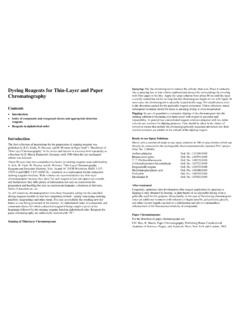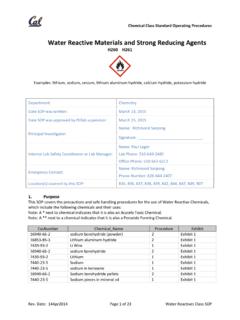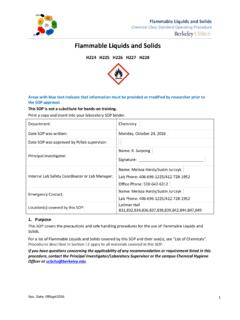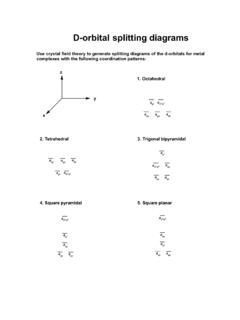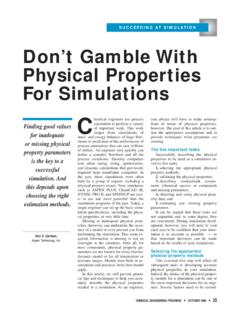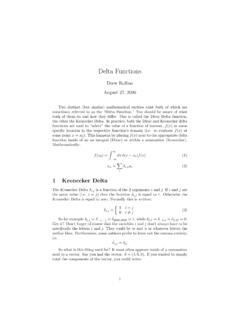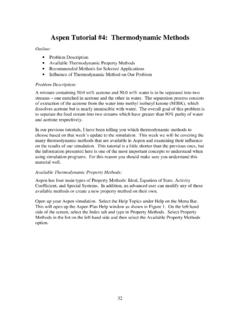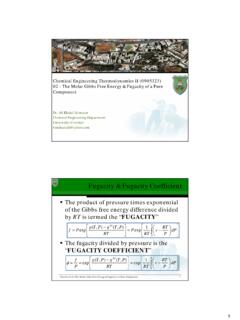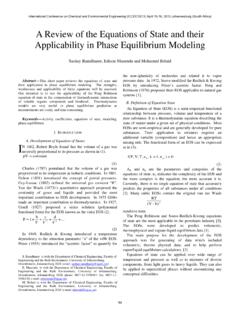Transcription of A Modified Soave Equation of State for Phase Equilibrium ...
1 Ind. Eng. Chem. Process Des. Dev., Vol. 17, No. 4, 1978 443 p = density pL = density of liquid, lb/ft3 pg,pv = air or vapor density, lb/ft3 0 = surface tension, dyn/cm 4 = froth density factor +,.J = as given in eq 15 $h = as given in eq 14 & = entrainment factor eq 28 Literature Cited Research Studies, Final ReDorts. Delaware. Michiaan. North Carolina. - Dee 1958. Bain, J. L., Van Winkle, M., AIChE J., 7 (3), 363 (1961). Calderbank, P. H., Trans. Inst. Chem. Eng., 34, 79 (1956). Chase, J. D., Chem. Eng., 105 (July 1967); 139 (Aug 1967). Eduljee, H. E.
2 , Chem. Age (India), 17, (7), 560 (1966). Fair. J. Matthewa. R. Pet. Refiner. 37 14). 153 11958). - Dee 1958. Bain, J. L., Van Winkle, M., AIChE J., 7 (3), 363 (1961). Calderbank, P. H., Trans. Inst. Chem. Eng., 34, 79 (1956). Chase, J. D., Chem. Eng., 105 (July 1967); 139 (Aug 1967). Eduljee, H. E., Chem. Age (India), 17, (7), 560 (1966). Fair. J. Matthewa. R. Pet. Refiner. 37 14). 153 11958). Foss, A. S., Gerster, J. A., Chem. Eng. Prog:, 52, 28'(1956). Hutchinson, M. H., Buran, A. G, O'Connell, H. E., Chem. Eng. 53, 127 Hughmark, G. A., O'Connell, H.
3 E., Chem. Eng. Prog., 53, 127 (1957) (1952). Hunt, C. d'A., Hanson, D. N., Wilke, C. R., AIChE J., 1, 441 (1955). Liebson, J., Kelley, R. E., Bullington, L. A,, Pet. Refiner, 36, 127 (1957). McAllister, R. A., Mcginnis, P. H., Plank, C. A,, Chem. Eng. Sci., 9, 25 (1958). Mayfield, F. D., Chwch, W. L., Green, A. C., Rasmussen, R. W., Id. Eng. Chem., Ogboja, O., Thesis, University of Surrey, 1974. Prince, R. G. H., Int. Symp. Dist., Inst. Chem. Eng., 177 (1960). Sargent, R. W. H., Bernard, J. D. T., Trans. Inst. Chem. Eng., 44, 314 (1966). Smith, B. D., Fair, J.
4 R., "Design of Equilibrium Stage Processes", (Chapter on Perforated Trays by Fair), McGraw-Hill, New York, , 1963. Souders, M., Brown, G. G., Ind. Eng. Chem., 26, 98 (1934). Thomas, W. J., Final Report ABCMIBCPMA Distillation Symposium, London, p 181, 1964. Thomas, W. J., Campbell, M. M., Trans. Inst. Chem. Eng., 45, 53 (1967). Thomas, W. J., Haq, A. M., Id. Eng. Chem., Process Des. 15, 509 (1976). Van Winkle, M., "Distillation", p 536, McGraw-Hill, New York, , 1967. West, F. B., Chem. Eng. Sci., 266 (1952). Zanelli, S., Del Blanco, R., Chem. Eng.
5 J., 6, 181 (1973). Zenz, F. A., Pet. Refiner, 33 (2), 99 (1954): 36 (3), 179 (1957). 44 (9), 2238 (1952). Received for review August 1, 1977 Accepted April 25, 1978 A Modified Soave Equation of State for Phase Equilibrium Calculations. 1 Hydrocarbon Systems Michael S. Graboski and Thomas E. Daubert' Department of Chemical Engineering, The Pennsylvania State University, 165 Fenske Laboratory, University Park, Pennsylvania 16802 The Soave modification of the Redlich-Kwong Equation of State is shown to work well for the estimation of the vapor-liquid Equilibrium behavior of a wide variety of technically important hydrocarbon mixtures.
6 The American Petroleum Institute's Technical Data Book-Petroleum Refining recently adopted a Modified Soave procedure for vapor-liquid equilibria calculations. It is the purpose here to present the finished form of the correlation for treating mixtures of hydrocarbons of importance to the natural gas and petroleum refining industries. The complete correlation is fully generalized, requiring only the readily available characterization parameters to make Equilibrium calculations. The utility of the correlation is demonstrated by equilibria predictions for binary and multicomponent defined and undefined hydrocarbon systems.
7 Procedure Soave (1972) originally proposed a modification of the Redlich-Kwong Equation of State which introduced a third parameter, the acentric factor, and a temperature de- pendency into the cohesive energy term to account for the effect of nonsphericity on fluid P-V-T properties. The Modified Equation of State is given by RT aa p=-- u - b (u)(u + b) where a = ,:!/P,, b = ,, and a = f (TIT,, w). a is an empirical function developed from pure hydrocarbon vapor pressure data. The Equation of State was extended to mixtures by Soave using the van der Waals one-fluid (Reid and Leland (1965)) combining rules given as nn n 6 = C xjb, j=1 (3) where cyy a,, = (1 - CL,)(a,aLalal)1/2, The constant C,, is the interaction coefficient as de- scribed by Chueh and Prausnitz (1967).
8 It corrects for the effect of deviation from geometric mean combining rule for a6 and must be obtained from binary mixture data. To a good approximation C, is independent of temper- ature, pressure, and composition. For hydrocarbons, Soave suggested that Cij was zero. Vapor-liquid equilibria calculations for hydrocarbon mixtures presented in this paper indicate that this is a reasonable approximation. The fugacity coefficient of a component in a Phase is needed to predict Phase Equilibrium . Based on the Soave Equation of State , the fugacity coefficient is given by eq 4 for component i in an n-component system, where $i is bi In $i = -(Z - 1) - In (2 - B) - b a fugacity coefficient of component i, bi is the covolume constant of component i, aijaij is given by eq 2, A = ~MP f R2F, B = bP f RT, and Z is the compressibility factor.
9 Correlation Development for Pure Hydrocarbons The original Soave development was based on an ac- curate correlation of hydrocarbon vapor pressures in terms of reduced temperature, reduced pressure, and the acentric 0019-7882/78/1117-0443$ 0 1978 American Chemical Society 444 Table I. Hydrocarbons Based on the Soave Procedure Ind. Eng. Chem. Process Des. Dev., Vol. 17, No. 4, 1978 Summary of Vapor Pressure Errors of ~~ ~~ ~ average deviations no. of compound class data points psia % paraffins (Cl-C20) 1946 olefins (C2-Clo) 743 naphthenes (C,-C, ,) 597 aromatics (C6-C,o) 1157 factor.
10 By accurately correlating vapor pressure, the Equation of State is capable of accurately predicting the fugacity of fluids and therefore the Phase Equilibrium behavior. Specifically, Soave used the critical point and the vapor pressure at a reduced temperature of ( , the acentric factor) for a number of compounds to de- termine the function required to correlate vapor pressures. A limited set of critical pressures, critical temperatures, and acentric factors which are not totally consistent with the recommended American Petroleum Institute Data Book (1977) parameters were used in the original devel- opment.
